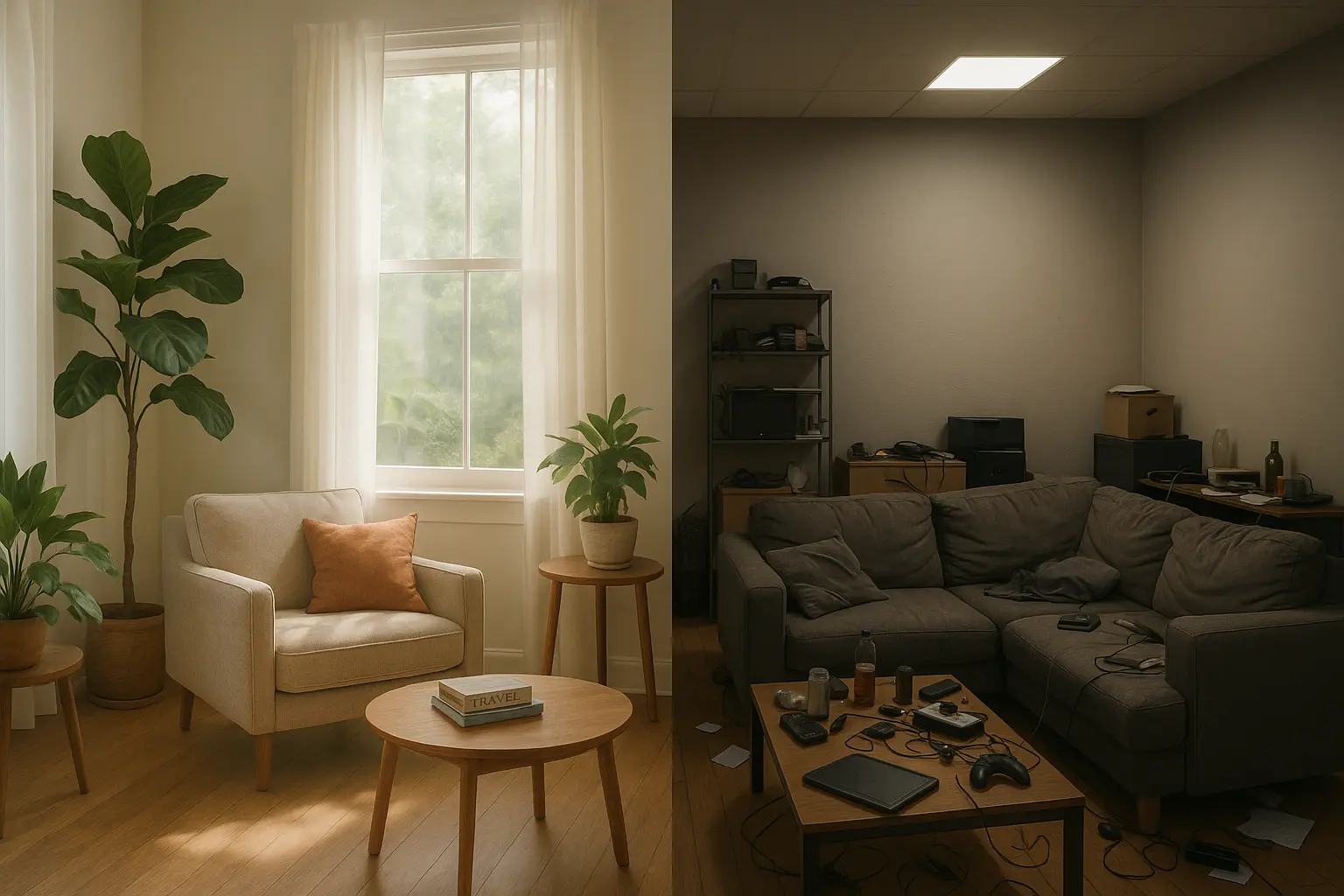With a background in wellness-oriented design, I know that carefully crafted spaces can provide essential psychological relief. At Curvspace, we design environments that serve as mental escapes, preventing fatigue and fostering well-being. This article explores design principles that transform spaces into stress-relieving sanctuaries, weaving in the importance of mental escapes and wellness design to create truly restorative stress relief spaces. We believe that even the often-overlooked “in-between” areas can become powerful zones for rejuvenation, a concept central to our philosophy at Curvspace.
Jump to:
The Pressing Need for Mental Escapes in Modern Life
In today’s hyper-connected, fast-paced world, don’t you often feel like your mind is a browser with too many tabs open? The constant barrage of notifications, societal pressures, and the sheer volume of information we process daily can lead to a pervasive sense of overwhelm and mental fatigue. It’s almost as if our internal batteries are perpetually hovering in the red. This is precisely why the concept of mental escapes has become not just a luxury, but a profound necessity for maintaining mental well-being.
Our surroundings play an incredibly significant role in how we feel, think, and function . Think about it: haven’t you ever walked into a room and instantly felt a sense of calm, or conversely, a wave of anxiety? This isn’t accidental. The design of a space-its light, color, sound, texture, and organization-directly impacts our psychological state . When these elements are thoughtfully orchestrated, a space can transform from a mere physical enclosure into a sanctuary for psychological relief. At Curvspace, we see this transformation as a cornerstone of effective wellness design.
But what exactly do we mean by “mental escapes”? It’s more than just a physical change of scenery. A true mental escape is a psychological retreat, a moment or a place that allows the mind to disengage from stressors, to wander freely, to rest, and to recharge. It could be a sun-drenched window seat where you lose yourself in a book, a quiet corner filled with plants that transports you to nature, or even a meticulously organized desk that brings a sense of clarity and control. These are the stress relief spaces we aim to cultivate.
The beauty of this concept lies in its accessibility. You don’t need to jet off to a remote island (though that sounds lovely!) to find psychological reprieve. As a designer, I’ve learned that profound mental escapes can be woven into the fabric of our everyday environments-our homes, our workplaces, and even the transitional, in-between spaces we often hurry through without a second thought . The goal is to create pockets of peace, calming environments that act as buffers against the relentless demands of modern life, fostering mindful spaces where we can reconnect with ourselves.
Why Our Brains Crave Restorative Environments
Our brains are wired to respond to our environment. Historically, this was a survival mechanism-scanning for threats or seeking out shelter and resources. While the threats have changed (emails instead of saber-toothed tigers, perhaps?), the underlying neural responses remain. Environments that are cluttered, chaotic, noisy, or poorly lit can trigger a low-level stress response, keeping us in a state of heightened alertness that, over time, depletes our mental and emotional resources .
Conversely, spaces designed with intention, incorporating elements of nature, harmonious colors, good lighting, and a sense of order, can signal safety and tranquility to our brains . This allows the parasympathetic nervous system-our “rest and digest” system-to take over, reducing heart rate, lowering blood pressure, and promoting a state of calm. It’s in these calming environments that creativity can flourish, focus can deepen, and genuine psychological relief can occur. This is the essence of wellness design: crafting spaces that actively support our mental well-being.
Consider the Japanese concept of shinrin-yoku, or “forest bathing.” It’s not about exercise, but about simply being in nature and connecting with it through our senses. Studies have shown that spending time in natural environments can reduce cortisol levels, boost the immune system, and improve mood. What if we could bring a sliver of that experience indoors through biophilic design? What if every space we inhabit had elements that offer a micro-dose of nature’s restorative power? These are the questions that drive us at Curvspace as we explore how to create potent mental escapes in even the most urban settings.
Core Principles: The Building Blocks of Wellness Design for Psychological Relief
Crafting spaces that genuinely offer psychological relief isn’t about following fleeting trends; it’s about applying timeless principles of wellness design. These principles work in concert to create environments that soothe the mind, uplift the spirit, and provide sanctuary from the everyday. As someone deeply immersed in creating stress relief spaces, I’ve seen firsthand how these elements can transform an ordinary room into an extraordinary mental escape.
Biophilic Design: Nature as Nurturer
I often say, “Nature itself is the best physician,” a sentiment attributed to Hippocrates that resonates deeply with wellness design. Biophilic design is the practice of connecting people with nature within the built environment . It’s more than just adding a potted plant here and there (though that’s a good start!). It involves integrating natural light, views of nature, natural materials like wood and stone, water features, and nature-inspired patterns and forms. Why does this matter so much? Because we have an innate, biological need to connect with the natural world. Fulfilling this need can significantly reduce stress, improve cognitive function, and enhance overall mental well-being . Imagine a workspace where, instead of staring at a blank wall, your gaze can rest on a vibrant green wall or a window framing a view of trees. That small shift can be a powerful source of psychological relief.

Color Psychology: Painting Your Mood
Have you ever noticed how different colors can evoke distinct emotional responses? That’s color psychology at play. For stress relief spaces, we often lean towards soft, muted colors found in nature-blues, greens, and earthy neutrals . These hues tend to have a calming effect on the nervous system, promoting relaxation and a sense of peace . Blues are often associated with serenity and stability, while greens can evoke feelings of growth, harmony, and refreshment. However, it’s not just about sticking to a limited palette. Accents of warmer, uplifting colors like soft yellows or corals can be used strategically to add joy and energy without overwhelming the senses. The key is balance and intention, creating calming environments that resonate on an emotional level. It’s a delicate dance, choosing shades that whisper tranquility rather than shout for attention.
Light: Illuminating Well-being
Light, both natural and artificial, is a powerful regulator of our mood and biological rhythms . Maximizing natural light is paramount in wellness design. Large windows, skylights, and open-plan layouts can flood spaces with daylight, which has been shown to boost mood, improve alertness, and support healthy sleep-wake cycles . When natural light is limited, the quality and type of artificial lighting become crucial. We can use layered lighting-ambient, task, and accent-to create different moods and functionalities. Tunable LED lighting that mimics the natural progression of daylight, from cool bright light in the morning to warm dimmer light in the evening, can further support our circadian rhythms and contribute to better mental well-being. Think about the difference between a harshly lit office and a room with soft, diffused, warm light – which one feels more like a mental escape?
Sound Design and Acoustics: The Symphony of Silence (and Sound)
In our noisy world, true quiet can feel like a luxury. Noise pollution is a significant stressor, impacting concentration, sleep, and overall mental health . Effective sound design is crucial for creating stress relief spaces. This can involve using sound-absorbing materials (like acoustic panels, plush textiles, and cork flooring), strategically placing furniture to break up sound waves, and designing layouts that create designated quiet zones . But it’s not always about complete silence. Sometimes, gentle, natural sounds-like the murmur of a water feature or soft, ambient music-can mask distracting noises and create a more soothing auditory environment. The goal is to curate a soundscape that supports relaxation and focus, transforming a space into a calming environment.
Texture and Materials: The Language of Touch
Our sense of touch plays a vital role in how we experience a space. Wellness design emphasizes the use of natural, tactile materials that feel good to the touch and connect us to the earth . Think of the warmth of wood, the coolness of stone, the softness of wool or linen, or the varied textures of plants. These materials not only add visual interest but also provide a sensory richness that can be incredibly grounding and comforting. In a world increasingly dominated by smooth, synthetic surfaces, incorporating diverse, natural textures can make a space feel more human, more inviting, and more conducive to psychological relief. Imagine running your hand over a rough-hewn wooden table versus a cold, laminate surface – the difference in feeling is palpable.
Spatial Layout and Organization: Flow and Freedom
“Have nothing in your house that you do not know to be useful, or believe to be beautiful,” William Morris famously advised. This sentiment speaks to the importance of decluttering and thoughtful organization in creating mindful spaces. Clutter can be a major source of stress and distraction, making it difficult to relax and focus. A well-designed spatial layout promotes a sense of flow and ease of movement. Clearly defined zones for different activities (e.g., a quiet reading nook, a social gathering area, a focused workspace) can help reduce mental friction. Ample storage solutions keep clutter at bay, allowing the mind to rest. The aim is to create environments where you feel a sense of spaciousness and order, key ingredients for a true mental escape.
Safety and Security: The Foundation of Calm
Before we can truly relax and let our guard down, we need to feel safe and secure in our surroundings . This is a fundamental aspect of wellness design. It encompasses physical safety (e.g., good lighting in hallways, non-slip floors, secure entry points) and emotional security (e.g., spaces that feel private and protected, environments free from intimidation). When these foundational needs are met, it creates a sense of peace of mind that allows for deeper relaxation and psychological relief . It’s about designing spaces where you can exhale, knowing you’re in a supportive and protected environment.
Accessibility and Inclusivity: Spaces for Every Body and Mind
A truly restorative space is one that welcomes everyone. Universal design principles, which aim to create environments that are usable by all people, to the greatest extent possible, without the need for adaptation or specialized design, are integral to wellness design . This means considering the needs of individuals with varying physical abilities, sensory sensitivities, and neurodiversity. Features like clear signage, accessible pathways, comfortable seating for different body types, and options for adjusting light and sound levels can make a space feel more inclusive and supportive for everyone . When a space is designed with empathy and consideration for diverse needs, it fosters a sense of belonging, which is vital for mental well-being.
Functionality and Comfort: Designed for Living Well
A beautiful space that isn’t comfortable or functional won’t provide much psychological relief. Ergonomics, comfortable furnishings, and layouts that support the intended use of the space are essential . Is the chair supportive for long periods of reading? Is the kitchen laid out in a way that makes cooking enjoyable rather than frustrating? Does the workspace promote good posture and reduce physical strain? These practical considerations are intertwined with our mental state. When our physical comfort is addressed, it frees up mental energy and allows us to more fully enjoy and benefit from our surroundings. It’s about creating spaces that not only look good but feel good to be in.
Multi-Sensory Design: Engaging All Our Senses
While vision often dominates our perception of design, a holistic approach to wellness design considers all our senses . How does the space smell? (Think aromatherapy with calming essential oils like lavender or chamomile, or simply the fresh scent of plants and good ventilation.) What are the tactile experiences? (Soft rugs underfoot, smooth wooden armrests.) What are the sounds, or the quality of silence? Even taste can be considered in spaces like kitchens or dining areas, promoting mindful eating of nutritious foods. By intentionally engaging multiple senses, we can create richer, more immersive mental escapes that fully envelop us in a state of calm and well-being.
These principles are not a rigid checklist, but rather a palette of tools and considerations that we, as designers at Curvspace, use to craft bespoke stress relief spaces. The magic happens when these elements are woven together thoughtfully, creating a harmonious whole that nurtures both body and mind.
Crafting Your Personal Sanctuaries: Mental Escapes in Every Corner of Life
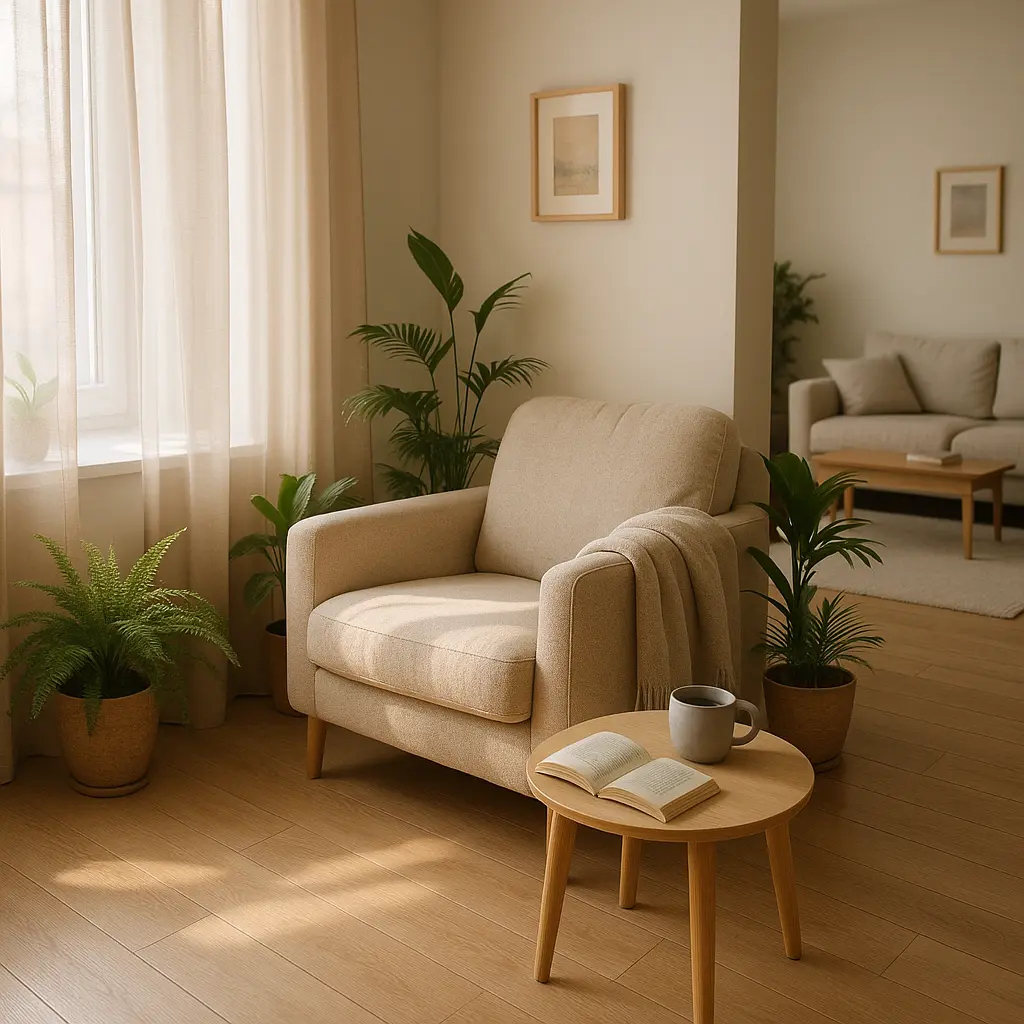
The beauty of wellness design is its adaptability. You don’t need a sprawling mansion or a complete renovation to create mental escapes; these havens for psychological relief can be cultivated in various settings, from the intimate corners of your home to the bustling environment of your workplace, and even in the public spaces you frequent. Let’s explore how we can weave these principles into different areas of our lives.
Mental Escapes at Home: Your Personal Retreat
Our homes should be our ultimate sanctuaries, the places where we can truly unwind and be ourselves. “The ache for home lives in all of us, the safe place where we can go as we are and not be questioned,” Maya Angelou beautifully articulated. How can we make this “safe place” even more supportive of our mental well-being?
- The Dedicated Quiet Corner: Even in the smallest apartment, can you carve out a nook dedicated to calm? Perhaps it’s a comfortable armchair by a window with a small bookshelf and a soft lamp . This becomes your go-to spot for reading, meditation, or simply quiet contemplation. What if this corner had a “sensory kit” – a soft blanket, a calming scent, noise-canceling headphones – to deepen the escape?
- The Bedroom as a Sleep Sanctuary: Quality sleep is foundational to mental health. Transform your bedroom into a haven for rest by minimizing clutter, using calming colors, investing in comfortable bedding, and ensuring complete darkness with blackout curtains. Keep electronics out – easier said than done, I know, but so crucial!
- Living Spaces for Connection and Calm: Design your living areas to support both relaxation and meaningful connection. Comfortable seating arrangements that encourage conversation, soft lighting, and touches of nature can create an inviting atmosphere. Can you incorporate a “no-tech” zone or time in these shared spaces to foster presence?
- Bringing the Outdoors In (and Vice Versa): If you have a balcony, patio, or garden, treat it as an extension of your living space. Fill it with plants, comfortable outdoor furniture, and perhaps a small water feature. Even a window box brimming with herbs or flowers can provide a vital connection to nature and a mini mental escape . How can that tiny urban balcony become a surprisingly lush, green refuge, a personal jungle in the concrete?
One common assumption is that creating a stress relief space at home requires significant investment. I challenge that by suggesting that often, the most impactful changes are small and intentional: decluttering a single shelf, adding one beautiful plant, or changing a harsh lightbulb to a warmer one. These micro-efforts accumulate to create a genuinely calming environment.
Mental Escapes at Work: Fostering Well-being and Focus
We spend a significant portion of our lives at work, and the design of our workplaces profoundly impacts our stress levels, productivity, and overall mental well-being . Forward-thinking companies are increasingly recognizing the importance of wellness design in creating environments where employees can thrive, not just survive.
- Quiet Rooms and Focus Pods: Open-plan offices can be challenging for concentration and can contribute to sensory overload. Dedicated quiet rooms or individual focus pods provide much-needed respite for deep work or simply a moment of calm away from the buzz .
- Wellness Rooms and Respite Areas: These are spaces designed specifically for relaxation and rejuvenation, perhaps equipped with comfortable seating, soft lighting, and even resources for mindfulness or meditation . Could these rooms offer guided audio meditations or nature soundscapes?
- Biophilic Workplaces: Integrating plants, natural materials, views of nature, and ample natural light into the office design can reduce stress, improve mood, and even boost creativity . Imagine “micro-breaks” where employees can step into a small, nature-infused pod for five minutes to reset.
- Flexible and Ergonomic Workspaces: Offering a variety of work settings-from collaborative zones to individual workstations, standing desks to comfortable lounge areas-caters to different tasks and preferences, allowing employees to choose an environment that best supports their needs at any given moment . This flexibility can reduce feelings of being “stuck” and enhance a sense of autonomy.
At Curvspace, we often think about how the journey to a workstation or meeting room can be designed. What if hallways weren’t just corridors but “mindful pathways” with art or subtle natural elements that offer a brief mental escape?
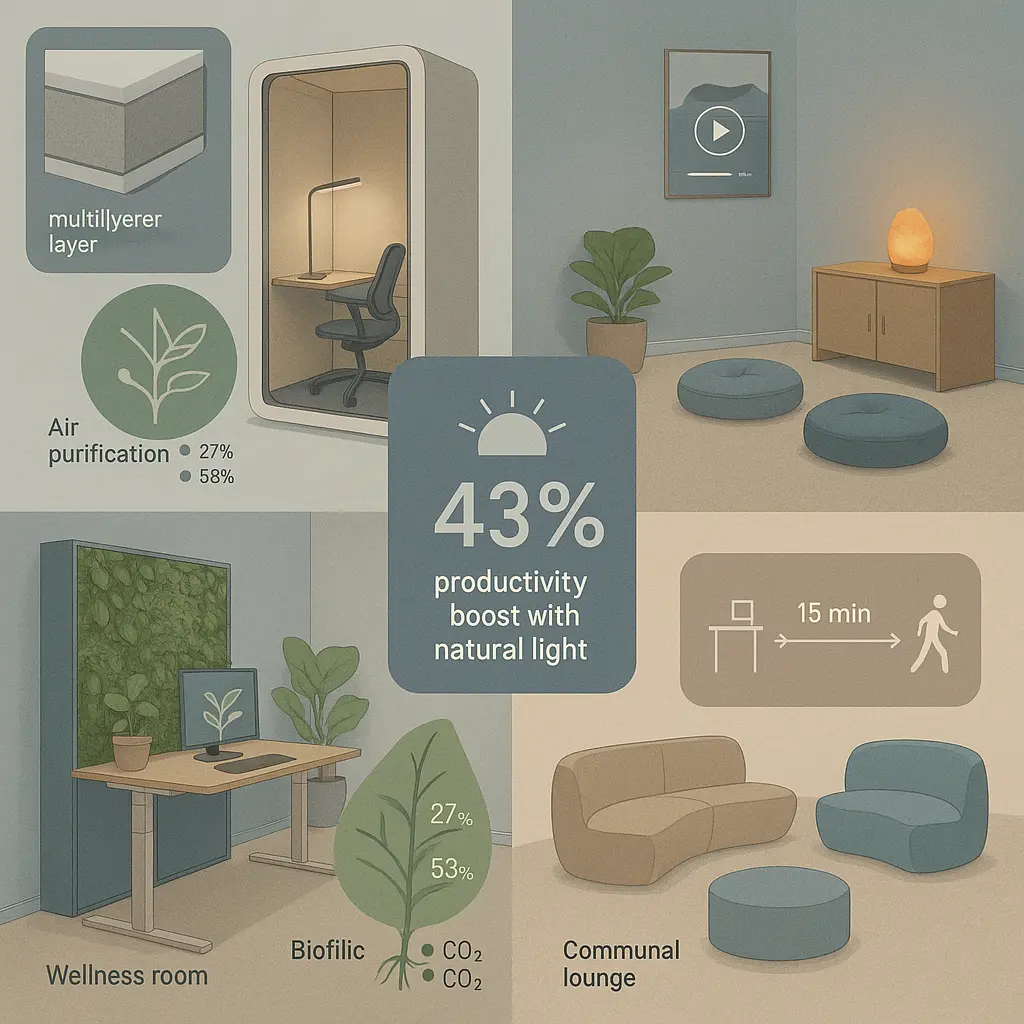
Mental Escapes in Public and Community Spaces: Oases for All
Psychological relief shouldn’t be confined to private spaces. Thoughtfully designed public and community areas can play a crucial role in supporting the mental well-being of entire populations.
- Parks and Urban Green Spaces: Access to nature is a public health imperative. Parks, community gardens, and even small “pocket parks” provide vital opportunities for relaxation, recreation, and connection with the natural world . How can we transform underutilized urban plots, like forgotten alleyways or bleak concrete plazas, into vibrant micro-retreats that offer a daily dose of nature?
- Libraries as Calming Hubs: Modern libraries are evolving beyond just book repositories into community hubs that often incorporate quiet zones, comfortable seating, natural light, and spaces for learning and contemplation, making them inadvertent stress relief spaces.
- Community Wellness Centers: These facilities can offer a range of services and spaces designed to support both physical and mental health, from fitness areas to meditation rooms and workshop spaces.
- Healing Architecture in Healthcare: Hospitals and clinics are increasingly adopting wellness design principles to create less stressful, more healing environments for patients, families, and staff. This includes maximizing natural light, incorporating nature views, using calming colors, and reducing noise . Maggie’s Centres in the UK are a pioneering example of this approach.
The challenge often lies in advocating for these features in public projects. But the long-term benefits for community mental well-being are immeasurable.
Threshold Spaces: The Curvspace Philosophy of In-Between Moments
At Curvspace, we have a particular fascination with “threshold spaces” – those transitional, often overlooked areas like entryways, hallways, waiting rooms, stairwells, and lobbies . These are the “in-between” moments of our day. We believe these spaces hold immense, untapped potential to become mini mental escapes.
Think about a typical waiting room. Often, it’s an afterthought, a sterile box filled with uncomfortable chairs and outdated magazines. What if, instead, it was designed as a “pause portal”? A space that uses soft lighting, comfortable seating, biophilic elements, and perhaps calming art or music to gently ease you into your next engagement, offering a moment of psychological relief rather than added stress.
Or consider a hallway. Is it merely a conduit from A to B, or could it be an experiential journey? Perhaps with curated artwork, changing light patterns, or textural wall surfaces that invite a moment of mindful touch. By paying attention to these transitional zones, we can infuse moments of calm and restoration into the very fabric of our daily routines, transforming mundane transitions into opportunities for mindful spaces and brief mental escapes. This is where Curvspace seeks to innovate, finding design solutions that elevate the everyday.
The Mind’s Role: Engaging with Your Designed Escapes
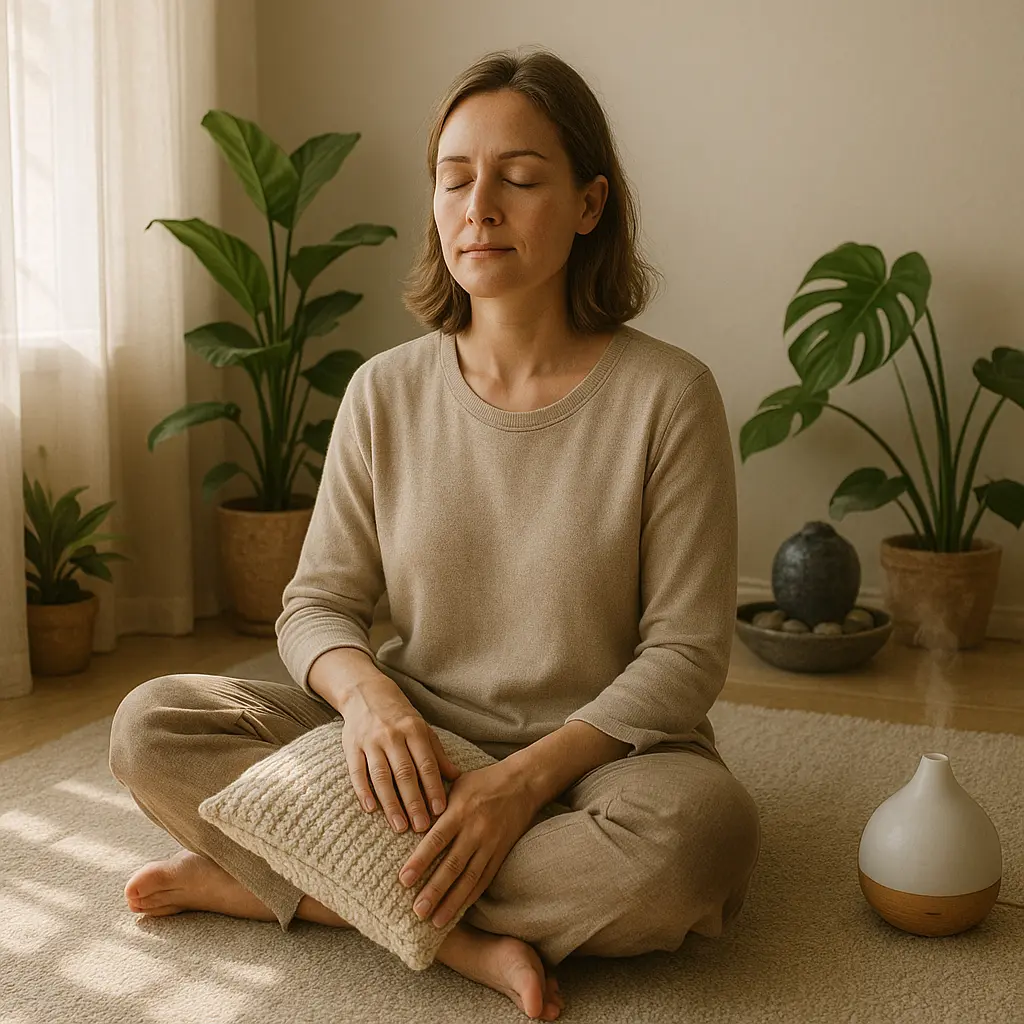
It’s one thing to craft a beautiful, calming space, but it’s another to truly experience its benefits. The most thoughtfully designed mental escape won’t offer much psychological relief if our minds are still racing or we’re not present enough to engage with it. This is where mindfulness and intention come into play. As a designer, I can create the stage, but you, the occupant, are the actor who brings the scene to life.
How often do you find yourself physically in a peaceful setting, yet mentally miles away, replaying a stressful conversation or worrying about your to-do list? I know I’ve been there. That’s why fostering an intentional connection with our surroundings is just as important as the design itself.
Mindful Interaction: Awakening Your Senses
A core principle of wellness design is its multi-sensory nature. To fully benefit from a stress relief space, we need to consciously engage our senses.
- See: Don’t just glance at the plant in the corner; truly see the intricate patterns on its leaves, the subtle variations in its green hues. Notice how the light falls, creating shadows and highlights.
- Hear: Tune into the sounds of your space. Is it the gentle hum of a fan, birdsong from an open window, or the intentional quiet of a sound-proofed room? If there are distracting noises, can you consciously redirect your attention to more pleasant sounds, or even introduce a calming soundscape?
- Touch: Interact with the textures around you. Feel the smoothness of a polished stone, the softness of a velvet cushion, the coolness of a metal surface, or the roughness of a natural fiber rug underfoot. These tactile sensations can be incredibly grounding.
- Smell: What are the scents in your space? Is it the fresh aroma of coffee, the calming scent of lavender from a diffuser, or the clean smell after a rain shower through an open window? Purposeful aromatherapy can significantly enhance a mental escape.
- Taste (where appropriate): In a kitchen or dining area designed for mindful eating, savor the flavors and textures of your food. This too can be a form of psychological relief.
By consciously engaging our senses, we anchor ourselves in the present moment, allowing the calming environment to work its magic more effectively . It’s like turning up the volume on the restorative qualities of the space.
Creating Rituals within Your Sanctuaries
Rituals can transform a simple space into a sacred one. These don’t need to be elaborate ceremonies. A ritual could be as simple as:
- Making a cup of herbal tea and enjoying it in your quiet corner every evening.
- Spending five minutes stretching or doing deep breathing exercises by your favorite window each morning.
- Lighting a specific candle or playing a particular piece of music when you want to transition into a state of relaxation.
- Mindfully tending to your indoor plants once a week.
These small, consistent actions create powerful associations. Over time, the mere act of stepping into your designated mental escape and performing your ritual can trigger a relaxation response. It’s about programming your mind and body to recognize that this space, and this activity, means it’s time to unwind.
Your Active Participation: A Creative Exercise
Let’s try a little imaginative exercise to spark your creativity in shaping your own mental escapes. This is something I often suggest to clients when we begin the wellness design process for their personal spaces. It’s called “Imagine Your Calm Place,” inspired by art therapy techniques.
- Find a quiet moment: Give yourself 10-15 minutes without distractions.
- Close your eyes (or soften your gaze): Take a few deep breaths.
- Visualize your ideal calm place: It doesn’t have to be a real place; it can be entirely from your imagination. What does it look like? Is it indoors or outdoors? What time of day is it?
- Engage your senses in this imagined space:
- What colors do you see? Are they soft and muted, or vibrant and energizing?
- What sounds do you hear? Is it silent, or are there gentle natural sounds like waves, wind, or birdsong?
- What textures can you feel? Is there soft grass beneath your feet, a smooth stone in your hand, a cozy blanket around you?
- Are there any particular scents? Fresh rain, blooming flowers, salty sea air?
- How do you feel in this space? Focus on the emotions it evokes – peace, safety, joy, contentment.
- Open your eyes and jot down some notes or sketch it out: What elements from this imagined sanctuary could you realistically incorporate into your actual living or working environment?
This exercise isn’t just daydreaming; it’s a way to tap into your subconscious preferences for what constitutes a calming environment for you. Perhaps you realized you crave more natural light, or the sound of water is deeply soothing to you. These insights can become the starting point for creating or enhancing your own stress relief spaces.
Remember, a mental escape is a co-creation between the designer (or you, as the designer of your personal space) and the user. The space provides the potential; your mindful engagement unlocks its full power for psychological relief and mental well-being.
Weaving in Technology: Enhancing, Not Engulfing, Our Mental Escapes
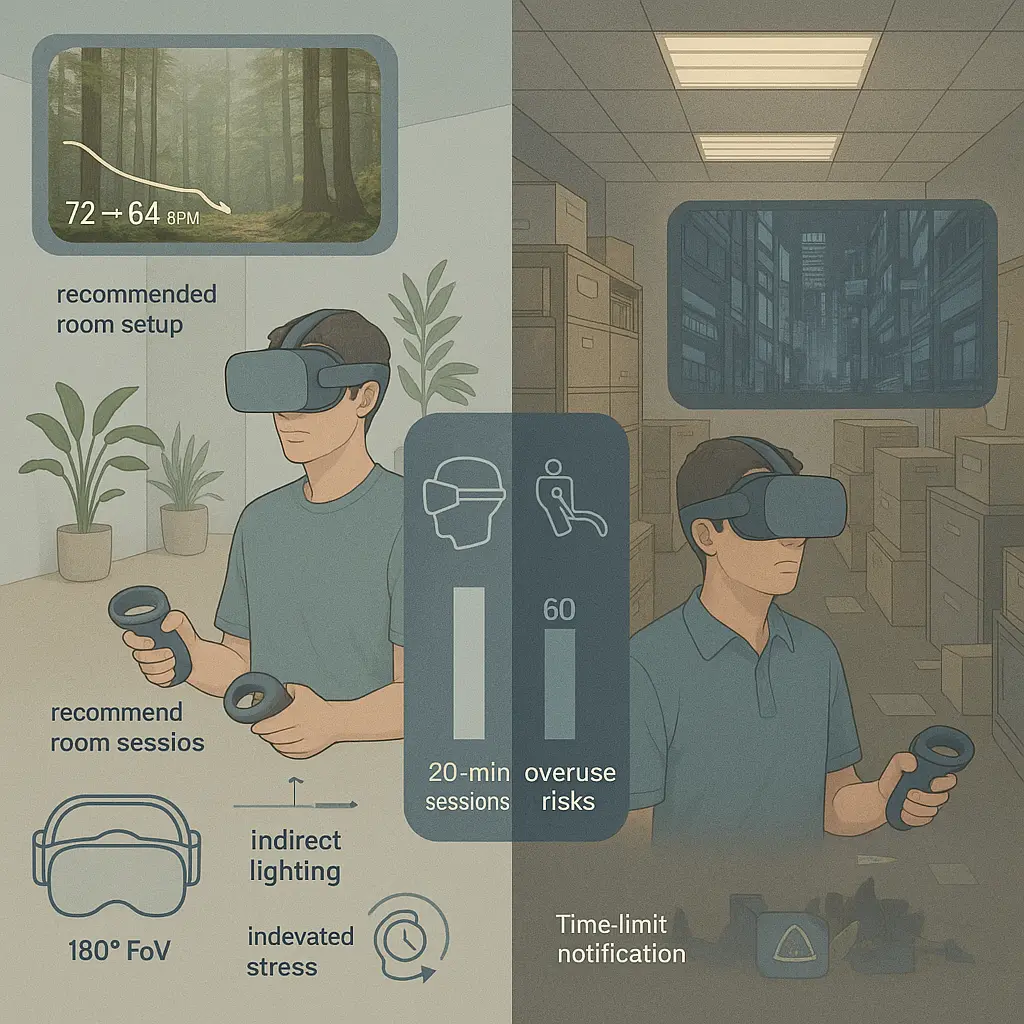
In our quest for mental escapes and psychological relief, it might seem counterintuitive to talk about technology, often seen as a primary source of modern stress. However, when used thoughtfully and intentionally, technology can actually be a powerful ally in wellness design, helping us craft even more effective stress relief spaces. The key is to ensure technology serves our well-being, rather than detracting from it.
Smart Lighting for Natural Rhythms
One of the most impactful ways technology can enhance calming environments is through smart lighting systems . As I mentioned earlier, light profoundly affects our circadian rhythms and mood. Modern LED lighting can be programmed to mimic the natural progression of daylight – cooler, brighter light in the morning to promote alertness, gradually shifting to warmer, dimmer light in the evening to signal the body it’s time to wind down . This “human-centric lighting” can be particularly beneficial in spaces with limited natural light, helping to regulate sleep patterns and improve overall mental well-being. Imagine your home office subtly adjusting its light temperature throughout the day, supporting your focus and then gently easing you towards evening relaxation.
Curated Soundscapes for Tranquility
While we often strive for quiet in our mental escapes, sometimes curated sound can be more effective than silence, especially in environments where complete quiet is unattainable . Technology offers a wealth of options here:
- Ambient Sound Machines: These devices can play a variety of soothing sounds like rainfall, ocean waves, white noise, or forest ambiances, masking distracting background noise and promoting relaxation or focus.
- Smart Speaker Integration: Smart speakers can be programmed to play calming playlists, guided meditations, or nature soundscapes on command, seamlessly integrating auditory wellness into your space.
- Noise-Canceling Technology: In shared or noisy environments, noise-canceling headphones can create an instant personal sanctuary, allowing for focus or rest.
The goal is to use sound to shape the atmosphere positively, contributing to a more immersive stress relief space.
Virtual Reality: Immersive (but Mindful) Escapism
Virtual Reality (VR) offers a fascinating, though more complex, avenue for creating mental escapes. VR can transport you to a serene beach, a lush forest, or even a fantastical landscape, providing a powerful, immersive break from reality. Some studies are exploring VR for stress reduction and pain management . However, it’s crucial to approach VR with mindfulness. While it can offer a temporary reprieve, it shouldn’t become a substitute for engaging with and improving our real-world environments or addressing the root causes of stress. Perhaps VR could be used as a tool to inspire the design of physical wellness design features – what elements of a virtual calming environment resonate most and could be translated into tangible reality?
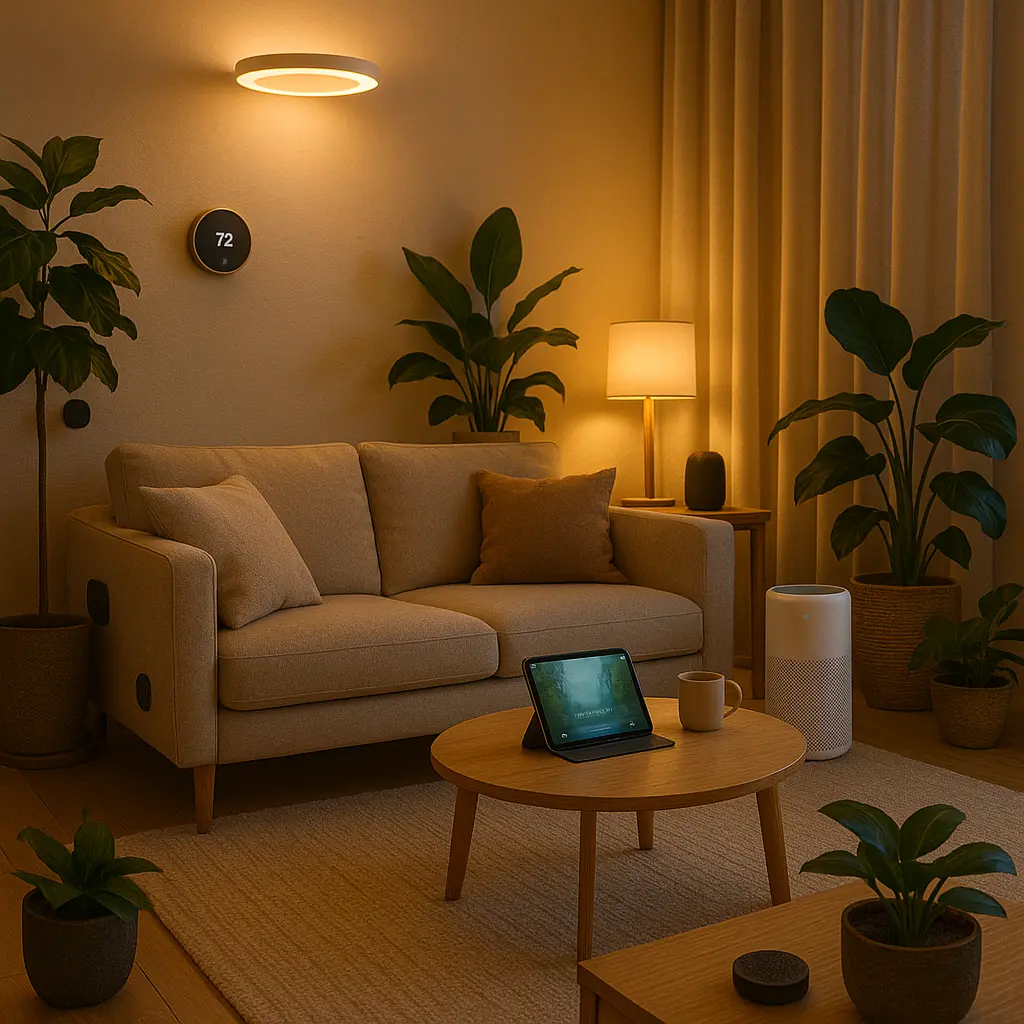
Smart Home Integration for Effortless Comfort
Beyond specific wellness technologies, general smart home features can contribute to a more stress-free environment. Automated blinds that adjust to optimize natural light, thermostats that maintain a comfortable temperature, and voice-activated controls that simplify daily tasks can all reduce minor irritants and free up mental space. When the environment effortlessly supports your comfort, it’s easier to relax and find psychological relief.
The Crucial Caveat: Avoiding Tech Overload
The most important principle when integrating technology into mental escapes is intention. The aim is to enhance tranquility, not to add another layer of digital distraction.
- Minimize Screens: In spaces designed for rest and rejuvenation, screens should ideally be absent or hidden. The blue light and stimulating content from phones, tablets, and TVs can interfere with relaxation and sleep.
- Choose Intuitive Interfaces: Any technology used should be simple and intuitive to control. Fumbling with complicated apps or remotes can be a source of frustration, negating the intended calming effect.
- Prioritize “Invisible Tech”: The best wellness technology often works quietly in the background, like an air purifier improving air quality without you needing to think about it, or a lighting system that adjusts automatically.
- Remember the “Off” Switch: Sometimes, the most profound mental escape comes from disconnecting entirely. Ensure it’s easy to turn off or disengage from technology when you crave pure, unadulterated quiet and presence.
As a designer at Curvspace, I see technology as a palette of tools. Used wisely, it can add subtle but powerful layers to our wellness design strategies, helping to craft even more effective and personalized stress relief spaces. The guiding question should always be: does this piece of technology genuinely contribute to psychological relief and mental well-being, or does it risk becoming another demand on our attention?
The Horizon of Healing Spaces: Future Trends in Wellness Design
The field of wellness design is constantly evolving, driven by new research, technological advancements, and a growing societal awareness of the profound link between our environments and our mental well-being. As we look to the future, several exciting trends are emerging that promise to make our mental escapes even more attuned to our individual needs for psychological relief.
Hyper-Personalization: Spaces That Know You
Imagine a stress relief space that adapts to your real-time physiological and emotional state. This isn’t science fiction. With the rise of wearable biosensors that can track heart rate variability, stress levels, and even brainwave activity, future environments might be able to:
- Adjust lighting intensity and color temperature based on your current stress or energy levels.
- Subtly change the ambient soundscape to promote calm if it detects agitation.
- Release specific aromatherapy scents conducive to relaxation or focus.
This level of personalization could create mental escapes that are uniquely responsive, offering tailored support for your mental well-being precisely when you need it. The challenge, of course, will be to implement this ethically and without creating an intrusive, overly monitored environment.
Neuroarchitecture: Designing with the Brain in Mind
Neuroarchitecture is an emerging field that combines neuroscience, architecture, and psychology to understand how the built environment affects our brains and bodies . By using tools like fMRI (functional Magnetic Resonance Imaging) and EEG (Electroencephalography) to study brain responses to different spatial configurations, lighting conditions, materials, and forms, designers can gain deeper insights into what truly creates calming environments and promotes psychological relief.
For example, research might reveal specific spatial proportions that are inherently more soothing, or patterns that reduce cognitive load. This data-driven approach could lead to more evidence-based wellness design strategies, moving beyond intuition to create spaces optimized for brain health and mental well-being.
Regenerative and Restorative Design: Beyond Sustainability
While sustainable design focuses on minimizing negative environmental impact, regenerative design aims to go a step further: creating spaces that actively restore and revitalize both human health and ecological systems. This involves:
- Deep Biophilia: Not just adding plants, but creating truly immersive natural environments indoors, perhaps with integrated ecosystems or large-scale vertical gardens that significantly improve air quality and provide a strong connection to nature .
- Healthy Materials: An even greater emphasis on non-toxic, natural, and locally sourced materials that support both human and planetary health.
- Spaces that Heal: Designing environments that actively contribute to recovery from stress, illness, or trauma, incorporating elements that promote rest, reflection, and rejuvenation.
This holistic approach sees human mental well-being as inextricably linked to the health of the planet, fostering a sense of interconnectedness that can itself be a source of psychological relief.
The Rise of Community-Centric Wellness Hubs
While personal mental escapes are vital, there’s a growing recognition of the importance of community and social connection for mental well-being . We may see an increase in:
- Neighborhood Wellness Hubs: Accessible local centers that offer a variety of resources, from mindfulness classes and therapy spaces to communal gardens and creative workshops, all designed with wellness design principles.
- Co-living and Co-working Spaces with a Wellness Focus: Environments designed not just for shared living or working, but for fostering a supportive community and integrating well-being practices into daily life.
- Intergenerational Spaces: Places designed to bring together people of different ages, promoting social interaction and mutual support, which can combat loneliness and enhance mental well-being.
These spaces acknowledge that true psychological relief often comes not just from solitude, but from feeling connected and supported by others.
The “In-Between” Elevated: Curvspace and the Future of Thresholds
At Curvspace, we believe the design of transitional, “in-between” spaces will become increasingly important . As life becomes more fragmented and fast-paced, these often-neglected moments of transition – walking down a corridor, waiting for an elevator, entering a building – offer precious opportunities for micro-doses of mental escape and psychological relief.
Imagine:
- Interactive Hallways: Corridors that subtly change lighting or display calming digital art as you walk through, offering a moment of mindful engagement.
- Elevator Lobbies as “Recharge Zones”: Small, beautifully designed spaces with comfortable seating and biophilic elements where you can take a breath before your next meeting.
- Entryways as “Transition Portals”: Foyers that use scent, sound, and light to help you consciously shift from the stress of the outside world to the calm of the interior environment.
By thoughtfully designing these thresholds, we can weave moments of restoration into the very fabric of our daily movements, creating a more continuous experience of mental well-being.
The future of wellness design is bright and full of potential. As our understanding of the mind-body-environment connection deepens, so too will our ability to craft spaces that are not just aesthetically pleasing, but truly nurturing, supportive, and restorative – genuine sanctuaries for the soul in an ever-changing world.
People Also Ask
What is the quickest way to make a room feel more calming?
One of the quickest ways is to declutter the space and introduce natural elements. Removing unnecessary items reduces visual noise, which can be instantly calming. Then, add a plant or two, open a window for fresh air and natural light if possible, and perhaps incorporate a soft, natural texture like a cozy throw blanket. These simple changes can significantly shift the atmosphere towards a more calming environment.
How can wellness design help with anxiety?
Wellness design can help alleviate anxiety by creating environments that signal safety, reduce sensory overload, and promote relaxation. Features like soft, muted color palettes (blues and greens), ample natural light, good acoustics to minimize jarring noises, biophilic elements (like plants or nature views), and organized, clutter-free layouts can all contribute to lowering stress levels and fostering a sense of peace, providing psychological relief. Designated quiet zones for reflection or meditation are also beneficial.
Can I apply wellness design principles to a small apartment?
Absolutely! Wellness design is about principles, not necessarily square footage. In a small apartment, focus on maximizing natural light with sheer curtains or mirrors, using a light and airy color palette to create a sense of spaciousness, and incorporating multi-functional furniture to reduce clutter. Vertical gardens or hanging plants can bring in nature without taking up floor space. Creating a small, dedicated “calm corner” with a comfortable cushion and a soft light can serve as your personal mental escape, even in a compact home.
Conclusion
Crafting spaces for psychological relief is an art and a science, a thoughtful blend of design principles aimed at nurturing our mental well-being. From harnessing the power of biophilia and color to optimizing light and sound, wellness design offers a pathway to transform everyday environments into restorative mental escapes. At Curvspace, we’re passionate about creating these stress relief spaces, particularly in those often-overlooked transitional zones. We invite you to explore how intentional design can enhance your life. Ready to transform your space into a sanctuary? Contact Curvspace today to learn more about our wellness design services.
References
- Marymount University. (2025). Designing for Well-Being: The Role of Interior Architecture in Mental Health.
- Wold Architects and Engineers. (2025). Designing for holistic well-being: Integrating mental health and wellness into the built environment.
- Biofilico. (2024). What is wellness design in healthy buildings and wellbeing interiors?
- Meditopia. (2024). How to Create a Calm Environment.
- Pinterest – Justin M Rivera. (2025). MENTAL ESCAPES ideas. (General visual inspiration)
- Healthline. (2025). 32 Mindfulness Activities to Find Calm at Any Age.
- Illustrarch. (2024). Top Features of Spaces Designed to Improve Mental Health.
- Mind Remake Project. (2020). 37 Powerful Therapy Metaphors. (General therapy concept)
- They Are The Future. (2024). Mental Health Drawing Ideas: Creative Therapy.
Disclosure
Our content is reader-supported. This means if you click on some of our links, then we may earn a commission. Commissions do not affect our editor’s opinions or evaluations. Learn more about our editorial process.

About the Editorial Staff
The Curvspace editorial team comprises a diverse group of experts on intermediate and threshold spaces in homes and workplaces. Architects and interior designers, civil engineers and artists, environmental and behavioral psychologists, sociologists and anthropologists. All collaborate to create helpful content, that explores the full potential of these often-overlooked areas to enhance our daily lives.

